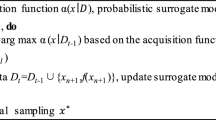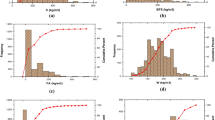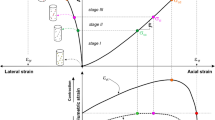Abstract
Bituminous pavements are greatly vulnerable to moisture damage. Most of the studies all over the world conclude that presence of moisture on road surface contributes significantly to pavement failures. Sustainable bituminous pavement needs high quality bitumen material. In roadway design, the tensile strength of bituminous pavements is an important engineering property. Indirect tensile strength (ITS) tests are performed on bituminous mixes for evaluating tensile strength ratio (TSR). Knowledge of TSR is helpful in determining the moisture susceptibility of bituminous concrete (BC) mixes for highway pavements. In the past different modelling techniques were developed to predict the TSR of bituminous mixes. In this study, support vector machines (SVM), M5 model tree and regression-based technique were used to estimate the TSR value of BC mixes. Two kernel functions, i.e. polynomial and radial-based kernel function were used with SVM model. Cross validation technique with 10-fold analysis was used for testing the models. SVM model with radial basis function (RBF) outclasses M5P model all in terms of correlation coefficient and R2 values. This paper proposes a simple linear equation for the prediction of the TSR, which is based on ITS tests performed on different types of bituminous mixes.








Similar content being viewed by others
References
Goel, G., & Sachdeva, S. N. (2019). Performance of bituminous concrete mixes with modified binder and anti-stripping agent. Indian Highways, 47(9), 25–30
Bhasin, A. (2006). Development of methods to quantify bitumen–aggregate adhesion and loss of adhesion due to wate, dissertation, Texas A&M University
Jakarni, F.M. (2012). Adhesion of asphalt mixtures. Ph.D. dissertation, University of Nottingham, Nottingham
Kandhal, P., & Rickards, I. (2001). Premature failure of asphalt overlays from stripping: Case histories. Asphalt Paving Technol, 70, 301–351
Little, D.N., Jones, D.R. (2003). Chemical and mechanical processes of moisture damage in hot-mix asphalt pavements. In: Proc., Moisture Sensitivity of Asphalt Pavements—A National Seminar. Washington, DC: Transportation Research Board (pp. 37–70)
Lottman, R.P. (1977). Predicting moisture-induced damage to asphaltic concrete-field evaluation. National Highway Research Council NCHRP Rep. No. 246. Washington, DC: Transportation Research Board
Lottman, R.P. (1978). Predicting moisture-induced damage to asphaltic concrete. National Research Council NCHRP Rep. No. 192. Washington, DC: Transportation Research Board
AASHTO T283. (2014). Resistance of compacted asphalt mixtures to moisture-induced damage. American Association of State Highway and Transportation Officials (AASHTO)
Solaimanian, M., et al. (2006). Simple performance test for moisture damage prediction in asphalt concrete. Journal of the Association of Asphalt Paving Technologists, 75, 345–380
Aschenbrener, T., Currier, G. (1993). Influence of testing variables on the results from the Hamburg wheel-tracking device: Final Report. Rep. No. COOT-D1D-R-93-22. Denver: Colorado Dept. of Transportation
Cross, S.A., Voth, M.D., Fager, G.A. (2000). Effects of sample pre-conditioning on asphalt pavement analyzer wet rut depth. In: Proc., Mid-continent Transportation Symp. Ames, IA: Iowa State Univ (pp. 20–23)
Copeland, A. R., Youtcheff, J., & Shenoy, A. (2007). Moisture sensitivity of modified asphalt binders: Factors influencing bond strength. Transporation Research Record, 1998(1), 18–28. https://doi.org/10.3141/1998-03
Buchanan, M.S. et al. (2004). Accelerated moisture susceptibility testing of hot mix asphalt (HMA) mixes. In: Proc., 3rd Annual Meeting of the Transportation Research Board. Washington, DC: Transportation Research Board
Mallick, R. B., Pelland, R., & Hugo, F. (2005). Use of accelerated loading equipment for determination of long term moisture susceptibility of hot mix asphalt. International Journal of Pavement Engineering, 6(2), 125–136. https://doi.org/10.1080/10298430500158984
Pinkham, R. et al. (2013). Use of moisture induced stress testing to evaluate stripping potential of hot mix asphalt (HMA). In: Proc., 92nd Annual Meeting of the Transportation Research Board. Washington, DC: Transportation Research Board
Ahmad, M., et al. (2017). Chemical and mechanical changes in asphalt binder due to moisture conditioning. Road Materials and Pavement Design, 19(5), 1216–1229. https://doi.org/10.1080/14680629.2017.1299631
Mallick, R. B., et al. (2019). Suitable tests and machine learning approach to predict moisture susceptibility of hot-mix asphalt. Journal of Transportation Engineering Part B Pavements, 145(3), 04019030. https://doi.org/10.1061/JPEODX.0000132
Abo-Qudais, S. A., & Al-Shweily, H. (2007). Effect of antistripping additives on environmental damage of bituminous mixtures. Building and Environment, 42(8), 2929–2938. https://doi.org/10.1016/j.buildenv.2005.05.017
Hefer, A.W. (2004). Adhesion in bitumen–aggregate systems and quantification of the effects of water on the adhesive bond. A dissertation, Texas A&M Universit
Chia, C. Y., & Tan, S. B. (1985). Stripping of road pavements and the effectiveness of some anti-stripping additives. Australian Road Research, 15(3), 174–177
Awanti, S. S., Amarnath, M. S., & Veeraragavan, A. (2008). Laboratory evaluation of SBS modified bituminous paving mix. Journal of Materials in Civil Engineering ASCE/April, 20, 327–330. https://doi.org/10.1061/(ASCE)0899-1561(2008)20:4(327)
Kok, B. V., & Yilmaz, M. (2009). The effects of using lime and styrene–butadiene–styrene on moisture sensitivity resistance of hot mix asphalt. Construction and Building Materials, 23(5), 1999–2006. https://doi.org/10.1016/j.conbuildmat.2008.08.019
Kumar, P., & Anand, P. (2012). Laboratory study on moisture susceptibility of dense graded mixes. Journal of Transportation Engineering ASCE, 138(1), 105–113. https://doi.org/10.1061/(ASCE)TE.1943-5436.0000306
Mohd Hasan, M. R., et al. (2015). Laboratory moisture susceptibility evaluation of WMA under possible field conditions. Construction and Building Materials, 101(1), 57–64. https://doi.org/10.1016/j.conbuildmat.2015.10.004
Ziari, H., Mirzababaei, P., & Babagoli, R. (2016). Properties of bituminous mixtures modified with a nano-organosilane additive. Petroleum Science and Technology, 34(4), 386–393. https://doi.org/10.1080/10916466.2015.1136948
Oliviero Rossi, C., et al. (2017). Adhesion promoters in bituminous road materials: A review. Applied Sciences, 7(5), 524–533. https://doi.org/10.3390/app7050524
Ameri, M., et al. (2018). Moisture susceptibility evaluation of asphalt mixtures containing Evonik, Zycotherm and hydrated lime. Construction and Building Materials, 165, 958–965. https://doi.org/10.1016/j.conbuildmat.2017.12.113
Solamanian, M. et al. (2003). Test method to predict moisture sensitivity of hot mix asphalt pavements. Moisture sensitivity of asphalt pavements: a national seminar, Topic 3, February, (pp. 4–6)
Lottman, R.P. et al. (1974). A laboratory test system for prediction of asphalt concrete moisture damage. Transportation Research Record 515, Characteristics of and Factors Influencing Bituminous Materials and Mixtures, Transportation Research Board, Washington, D.C. (pp. 18–26)
Lottman, R.P. (1982). Predicting moisture-induced damage to asphaltic concrete—field evaluation. NCHRP Report 246, Transportation Research Board, Washington, D.C. (pp. 50)
Kandhal, P.S. (1992). Moisture susceptibility of HMA mixes: Identification of problem and recommended solutions. NCAT Report 92-01
Majidzadeh, K., Brovold, F.N. (1968). State of the art: Effect of water on bitumen–aggregate mixtures. HRB, Special Report No. 98
Lu, Q., Harvey, J.T. (2008). Investigation of conditions for moisture damage in asphalt concrete and appropriate laboratory test methods. Caltrans Division of Research and Innovation, Research Report No.: UCPRC-RR-2005-15
Hamzah, M.O. et al. (2012). Development of dynamic asphalt stripping machine for better prediction of moisture damage on porous asphalt in the field. In: 7th RILEM International Conference on Cracking in Pavements RILEM, (pp. 71–81)
Lin, J., Chen, M., & Wu, S. (2012). Utilization of silicone maintenance materials to improve the moisture sensitivity of asphalt mixtures. Construction and Building Materials, 33, 1–6. https://doi.org/10.1016/j.conbuildmat.2012.01.012
Weerakoon, R., Kumar, A., Desha, C. (2013). Sustainability in post disaster road infrastructure recovery projects in Queensland, Australia. In: The Proceedings of the 9th Annual International Conference of the International Institute for Infrastructure Renewal and Reconstruction, Queensland University of Technology, Australia (pp. 101–108)
Li, N., Molenaar, A.A.A. (2012). Prediction of tensile strength of asphalt concrete. Sustainable Construction Materials. 275–286. https://doi.org/10.1061/9780784412671.0024
Nivedya, M., Mallick, R.B. (2018). Artificial neural network-based prediction of field permeability of hot mix asphalt pavement layers. International Journal of Pavement Engineering. 1–12. https://doi.org/10.1080/10298436.2018.1519189
Heukelom, W. (1966). Observations on the rheology and fracture of bitumens and asphalt mixes. Asphalt Paving Technology, 35, 358–399
Erkens, S.M.J.G. (2002). Asphalt concrete response—determination, modeling and prediction. PhD. thesis, Delft University of Technology, The Netherlands
Aggarwal, V. (2012). Experimental investigations on high performance fly ash cement concrete for pavements, Thesis, NIT, Kurukshetra, India
Pal, M., & Deswal, S. (2008). Modelling pile capacity using support vector machines and generalized regression neural network. Journal of Geotechnical and Geoenvironmental Engineering, 134(7), 1021–1024. https://doi.org/10.1061/(ASCE)1090-0241(2008)134:7(1021)
Jafarzadeh, A. A., et al. (2015). Comparative analysis of support vector machine and artificial neural network models for soil cation exchange capacity prediction. International Journal of Environmental Science and Technology, 13, 87–96. https://doi.org/10.1007/s13762-015-0856-4
Singh, G., Sachdeva, S. N., & Pal, M. (2016). M5 model tree based predictive modeling of road accidents on non-urban sections of highways in India. Accident Analysis and Prevention, 96, 108–117. https://doi.org/10.1016/j.aap.2016.08.004
Kandhal, P.S., Lynn, C.Y., Parker, F. (1998). Tests for plastic fines in aggregates related to stripping in asphalt paving mixtures. NCAT Report 98-03
Bagampadde, U. (2004). On investigation of stripping propensity of bituminous mixtures. Licentiate Thesis, Royal Institute of Technology, Stockholm, Sweden
Sengoz, B., & Agar, E. (2007). Effect of asphalt film thickness on the moisture sensitivity characteristics of hot-mix asphalt. Construction and Building Materials, 42(10), 3621–3628. https://doi.org/10.1016/j.buildenv.2006.10.006
Sergio, L., & Mauro, S. (1997). Concrete strength prediction by means of neural network. Construction and Building Materials, 11(2), 93–98. https://doi.org/10.1016/S0950-0618(97)00007-X
Cheng, Y. (1999). Design of high-performance concrete mixture using neural networks and non linear programming. Journal of Computing in Civil Engineering, 13(1), 36–42. https://doi.org/10.1061/(ASCE)0887-3801(1999)13:1(36)
Oh, J. W., Kim, J. T., & Lee, G. W. (1999). Application of neural networks for proportioning of concrete mixes. ACI Materials Journal, 96(1), 61–67
Dias, W. P. S., & Pooliyadda, S. P. (2001). Neural networks for predicting properties of concretes with admixtures. Construction and Building Materials, 15(7), 371–379. https://doi.org/10.1016/S0950-0618(01)00006-X
Zhang, Y., & Xie, Y. (2007). Forecasting of short-term freeway volume with v-support vector machines. Journal of the Transportation Research Board, National Research Council Washington DC, 2024, 92–99. https://doi.org/10.3141/2024-11
Zydex. (2018). Nanotechnology for asphalt pavement. https://zydexindustries.com/services/road/anti-stripping. Accessed 30 May 2018
Ministry of Road Transport and Highways (MoRTH). (2013). Specification for Roads and Bridge Works. New Delhi
IS: 2386 (Part III). (1963). Methods of test for aggregates for concrete-part 3 specific gravity, density, voids, absorption, bulking. Bureau of Indian Standards, India
IS: 2386 (Part IV). (1963). Methods of test for aggregates for concrete-part 4, mechanical properties. Bureau of Indian Standards, India
IS: 2386 (Part I). (1963). Methods of test for aggregates for concrete-part 1 particle size and shape. Bureau of Indian Standards, India
IS: 73. (2013). Paving bitumen-specification. Bureau of Indian Standards, India
IRC: SP: 53. (2010). Guidelines on use of modified bitumen in road construction. Indian Road Congress, New Delhi
IS: 73. (1992). Paving bitumen-specification. Bureau of Indian Standards, India
Goel, G., & Sachdeva, S. N. (2016). Rational evaluation of stripping and its control. Journal of Engineering, Science and Management Education JESME, 9(3), 196–202
Quinlan, J.R. (1992). Learning with continuous classes. In: Proceedings of Australian Joint Conference on Artificial Intelligence, World Scientific Press: Singapore (pp. 343–348)
Witten, I. H., & Frank, E. (2005). Data mining: Practical machine learning tools and techniques with java implementations. San Francisco: Morgan Kaufmann
Emerson, D., Nayak, R., Weligamage, J. (2011). Using data mining to predict road crash count with a focus on skid resistance values. In: 3rd International Road Surface Friction Conference, Gold Coast, Queensland, Australia
Vapnik, V. N. (1995). The Nature of statistical learning theory. New York: Springer
Vapnik, V. (1999). The nature of statistical learning theory. (2nd ed.). New York, NY, USA: Springer. 978-0-387-98780-4
Vapnik, V., & Chapelle, O. (2000). Bounds on error expectation for support vector machines. Neural Computation, 12(9), 2013–2036. https://doi.org/10.1162/089976600300015042
Bui, D. T., et al. (2016). Spatial prediction models for shallow landslide hazards: A comparative assessment of the efficacy of support vector machines, artificial neural networks, kernel logistic regression, and logistic model tree. Landslides, 13, 361–378. https://doi.org/10.1007/s10346-015-0557-6
Huang, S., et al. (2014). Monthly stream flow prediction using modified EMD-based support vector machine. Journal of Hydrology, 511, 764–775. https://doi.org/10.1016/j.jhydrol.2014.01.062
Xing, B., et al. (2015). Monthly mean stream flow prediction based on bat algorithm-support vector machine. Journal of Hydrologic Engineering, 21(2), 04015057. https://doi.org/10.1061/(ASCE)HE.1943-5584.0001269
Weiss, S. M., & Kulikowski, C. A. (1991). Computer systems that learn: classification and prediction methods from statistics, neural nets, machine learning, and expert systems. San Francisco, CA, United States: Morgan Kaufmann
Efron, B., & Tibshirani, R. J. (1997). Improvements on cross validation: The .632+ bootstrap method. Journal of American Statistical Association, 92, 548–560. https://doi.org/10.1080/01621459.1997.10474007
Kohavi, R. (1995). A study of cross-validation and bootstrap for accuracy estimation and model selection. In: Proceedings of 14th International Joint Conference on Artificial Intelligence (pp. 1137–1145)
XLSTAT (2017). Data analysis and statistical software for excel. Paris, France: Addinsoft
Author information
Authors and Affiliations
Corresponding author
Rights and permissions
About this article
Cite this article
Goel, G., Sachdeva, S.N. & Pal, M. Modelling of Tensile Strength Ratio of Bituminous Concrete Mixes Using Support Vector Machines and M5 Model Tree. Int. J. Pavement Res. Technol. 15, 86–97 (2022). https://doi.org/10.1007/s42947-021-00013-5
Received:
Revised:
Accepted:
Published:
Issue Date:
DOI: https://doi.org/10.1007/s42947-021-00013-5




